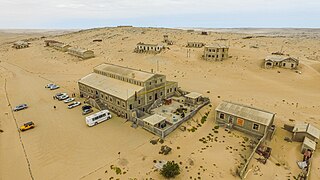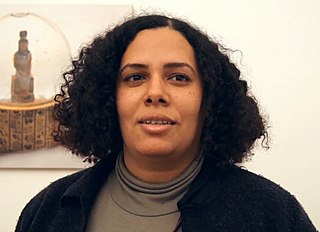Related Research Articles

Kolmanskop is a ghost town in the Namib in southern Namibia, 10 kilometres (6.2 mi) inland from the port town of Lüderitz. It was named after a transport driver named Johnny Coleman who, during a sand storm, abandoned his ox wagon on a small incline opposite the settlement. Once a small but very rich mining village, it is now a popular tourist destination run by Namdeb, a joint firm owned by the Namibian government and De Beers.
African Photography Encounters, more commonly known as Bamako Encounters, is a biennial exhibition in Bamako, Mali, held since 1994. It is the first and largest African photography biennial. The exhibition, featuring exhibits by contemporary African photographers, is spread over several Bamako cultural centers, including the National Museum, the National Library, the Modibo Keïta memorial, and the District Museum. The exhibition also features colloquia and film showings.

Bogenfels is a location in the coastal Namib Desert of Namibia, noted for its natural rock formations. The main formation is a 55-metre (180 ft) high rock arch close to the coast. It is not easily accessible, due to the terrain and its location within a restricted diamond-mining area Sperrgebiet, at 27° 28'S, about 95 kilometres (59 mi) south of Lüderitz and 32 kilometres (20 mi) south of Pomona but there are official guided tours.

Malick Sidibé was a Malian photographer from a Fulani (Fula) village in Soloba, who was noted for his black-and-white studies of popular culture in the 1960s in Bamako, Mali. Sidibé had a long and fruitful career as a photographer in Bamako, and was a well-known figure in his community. In 1994 he had his first exhibition outside of Mali and received much critical praise for his carefully composed portraits. Sidibé's work has since become well known and renowned on a global scale. His work was the subject of a number of publications and exhibited throughout Europe and the United States. In 2007, he received a Golden Lion for Lifetime Achievement at the Venice Biennale, becoming both the first photographer and the first African so recognized. Other awards he has received include a Hasselblad Award for photography in 2003, an International Center of Photography Infinity Award for Lifetime Achievement (2008), and a World Press Photo award (2010).

Simon Njami is a writer and an independent curator, lecturer, art critic and essayist.
Ayana V. Jackson is an American photographer and filmmaker. Born in Livingston, New Jersey. She is best known for her focus on Contemporary Africa and the African Diaspora, most notably the series African by Legacy, Mexican by Birth, Leapfrog Grand Matron Army, and Archival Impulse.
August Stauch was a German prospector who discovered a diamond deposits near Lüderitz, in German South West Africa.

Ananias Leki Dago is an Ivorian photographer.
James Iroha Uchechukwu is a Nigerian photographer. He was born in 1972 in Enugu. He is known for his photography, his support to young photographers, and the passing on of his knowledge to the young. He is also regarded at the beginning of the 21st century as someone that has broadened the horizon of Nigerian photography.
Maïmouna Guerresi is an Italian-Senegalese multimedia artist working with photography, sculpture, video, and installation. Her work incorporates Afro-Asian themes and symbolism with traditional European iconography.

Françoise Huguier is a French photographer.
Pélagie Gbaguidi (1965-) is a Beninese artist who lives and works in Brussels. She is most well-known for her series of paintings and drawings titled “le Code noir” which evokes the violence of the slave trade and its effected trauma on the following generations of Western African cultures.

Rana El Nemr is a visual artist based in Cairo, Egypt. Working primarily in photography, she has undertaken explorations of contemporary Egyptian urban life, including Cairo's architectural features, public/private spaces, middle-class identity, and the larger urban environment. Her artistic practice moves from formalist explorations of photography as a medium to genre-bending visual essays of her surroundings in Egypt. Her practice is anchored in questioning what it means to live and experience place and time, through recording, describing, and reflecting on this experience via photography, film, texts and conversations. El Nemr's artistic process incorporates formal image-making techniques with contemporary artistic practices, and it strives to integrate various forms of collaborations in different constellations, such as trans-disciplinary collaborations and alternative pedagogical practices among many others. She is a co-founder of the Contemporary Image Collective (CIC), an institution founded in 2004 in Downtown Cairo, whose programming includes lectures, screenings, and workshops that explore the changing role of photography in contemporary visual culture. El Nemr remains an active board member of CiC.
Kristin Capp is an American photographer, author and educator. Capp's work has been exhibited both nationally and internationally. Her work is included in collections at the Whitney Museum in New York, the Lyman Allyn Art Museum in Connecticut, the International Center of Photography in New York and the Harvard Art Museum. She was one of sixty international artists selected for the Göteborg International Biennial for Contemporary Art in 2017. Her work has appeared in the Bursa International Photofest in Turkey, as well as in Switzerland, France, Belgium, Germany and the United States.

Malala Andrialavidrazana is an artist and photographer from Madagascar, who lives in Paris. She has worked and exhibited internationally, and had two books of her photography published.
Fatoumata Diabaté is a Malian photographer from Bamako.

Mónica de Miranda is a Portuguese visual artist, photographer, filmmaker, and researcher of Angolan ancestry known for her artwork on socially inspired themes, including postcolonial issues of geography, history, and subjectivity related to Africa and its diaspora. Her media include photography, mixed media and video. De Miranda first became known for her photographic records of the ruins of modern hotels in post-war Angola, and their surrounding sociopolitical circumstances. Her photographic series, videos, short films, and installations have been internationally exhibited at art biennales, galleries, and museums, some of which keep her work in their permanent art collections. Her work has been reviewed in specialized art sources.
Margaret Courtney-Clarke is a Namibian documentary photographer and photojournalist, living in Swakopmund. Her work "frequently explores the resilience of communities enduring the rapidly shifting landscapes of Namibia." Courtney-Clarke has made a trilogy of books on the art of African women: Ndebele (1986), African Canvas (1990), and Imazighen (1996). She has collaborated on books with David Goldblatt and Maya Angelou.
Nicky Marais, born in 1962 in Rustenburg, South Africa, is a Namibian artist who lives and works in Windhoek. She has worked as a painter, mixed-media artist, activist, and educator.

Bouna Medoune Seye was a Senegalese painter, photographer, costume designer and filmmaker. Born in Dakar, Senegal, he studied in Marseilles, France, and photographed the tramps on the streets of Dakar for five years. He then started out in cinema as an art director and later film director.
References
- 1 2 3 4 5 Dakin, Dagara (2015). "Helga Kohl: Elisabeth Bay (1997)". In Silva, Bisi (ed.). Telling Time: Rencontres de Bamako, Biennale Africaine de la Photographie, 10ième édition. Heidelberg: Kehrer Verlag. pp. 110–115, 431. ISBN 978-3-86828-669-4. OCLC 930776525.
- 1 2 3 Milbourne, Karen (2013). Earth Matters: Land as Material and Metaphor in the Arts of Africa. New York: Monacelli Press. pp. 36–38. ISBN 978-1-58093-370-4. OCLC 918924058.
- 1 2 3 4 Njami, Simon (2005). "Helga Kohl: Namibie". VIes Rencontres Africaines de la Photographie, Bamako 2005, Un Autre Monde. Paris: E. Koehler. pp. 78–79. ISBN 978-2-7107-0725-7. OCLC 255157667.
- 1 2 3 SADC Arts and Craft Festival (2000). "Helga Kohl". SADC Arts & Craft Festival 2000 Catalogue. Windhoek, Namibia: National Art Gallery of Namibia and Ministry of Basic Education, Sport and Culture. pp. 14–15. ISBN 9789991650913.
- 1 2 Philander, Frederick (June 15, 2007). "Namibian Photographer Again Honoured". New Era .[ permanent dead link ]
- ↑ Parker, Lonnae O'Neal (April 21, 2013). "'Earth Matters,' at National Museum of African Art, looks at humanity's ties to planet". The Washington Post . ISSN 0190-8286.